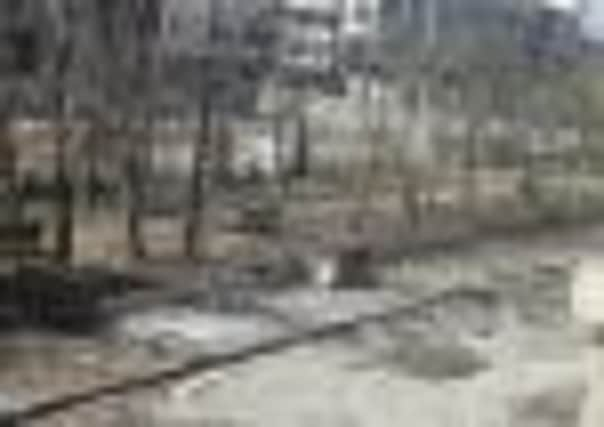Syria: Riven by war and sectarian hate, Homs is Syria’s shame


After months of military assaults and rebel ambushes, Homs – the centre of Syria’s 15-month-old revolt against president Bashar al-Assad – has effectively become two cities.
Along the scorched and crumbling skyline is a well-preserved archipelago of districts, home to Syria’s minority Alawite sect, the offshoot of Shiite Islam to which Mr Assad’s family belongs.
Advertisement
Hide AdAdvertisement
Hide AdAlawites have mostly sided with Mr Assad and have barricaded themselves in Homs – protected by the Syrian army that has now made their neighbourhoods a second home.
“We’re always nervous, but we will stay and survive,” says Abu Ali, a 60-year-old sitting in his mini market in the Alawite neighbourhood of Zahra.
“It is the Sunni areas that are empty – at least the ones that asked for ‘freedom’,” he said, referring to districts that backed the mainly Sunni Muslim uprising against Mr Assad.
The rebellious districts that once belonged to Sunni Muslims are ghost towns. Only about three of the 16 Sunni districts have not been pummelled by military assaults.
Many Alawites claim they have no choice but to back Mr Assad, fearing retaliatory slaughter for being of the same religion as the president as the revolt becomes increasingly sectarian.
“The Sunnis have been oppressed,” said one Alawite man. “But Alawites will be the victims.”
Abu Ali settles in his chair as cans and jars lined up in his shop rattle from the daily bursts of gunfire and rockets. Behind him, a portrait of Mr Assad looks down. “Those other people are the terrorists,” he says, pointing to several cases of Alawites being kidnapped or killed by rebels. “I can tell you what is happening: war.”
While many areas have until now escaped sectarian brutality, the heart of Syria’s conflict is a chilling glimpse of what the worst-case scenario may bring: a bloody struggle that tears the country into a jigsaw of warring statelets.
Advertisement
Hide AdAdvertisement
Hide AdThe regime in Damascus describes rebels fighting Mr Assad as foreign-backed terrorists and accuses international media of misrepresenting the situation as a popular uprising against the president. But it allows little access for foreign correspondents.
The city of Homs was once Syria’s industrial centre, sitting on its main north-south road, 20 miles east of the border with Lebanon. It became the stronghold of the armed insurgency that began several months ago and overtook the peaceful protests against 42 years of Assad family rule.
With Sunni areas pounded into a shambles, refugees too poor to leave Homs, have few options left.
Most end up in the Waar district, a jungle of concrete apartment blocks that housed the Sunni elite. Waar’s affluent residents fled the city’s chaos. Soon refugees broke in and took over their abandoned homes.
All down the streets, shops have been seized by refugees. At a butcher shop, a family has hung blankets across meat hooks outside to cover the glass front. Refugees have even moved into shopping precincts, and the former retail outlets are now filled with blankets and stoves.
Outside, Abu Omar begs for his six children, who have been given shelter in a local mosque.
“We’re living off the charity of others. And we are lucky, some people are on the streets,” he says. Homs used to be home to a million people. Now, residents claim at least half have fled.
Meanwhile, Alawite residential areas such as Farzat’s Zahra look like army bases.
Advertisement
Hide AdAdvertisement
Hide AdArtillery is no longer stored in barracks on the outskirts of Homs but in the middle of Alawite districts, and troops are at the ready to roll them out and fire at nearby rebel territories.
The army has secured the streets connecting Alawite districts. But its control of Homs is tenuous. Soldiers dare not go into most Sunni areas, where unseen in rocket- and bullet-riddled buildings, hundreds of rebels hide, sporadically firing rocket propelled grenades.
“If we wanted to end the Homs problem, we’d have to grind the whole place to the ground. Hundreds of soldiers would die,” said an army officer.
He said he was part of the siege of the Baba Amr neighbourhood, when an onslaught by tanks and troops drove rebels out of their main stronghold.
“We’re worried houses will be mined, as they were in Baba Amr. That struggle cost us many more men than was reported. So now instead, we just shell the rebel areas from here,” he added.
In addition to troops, hundreds of pro-Assad militia men have been cultivated, proudly accepting the label “shabiha”, from the Arabic word for “ghost.”
They strut the streets in army camouflage and speak disdainfully of soldiers they view as treading too cautiously in confronting the enemy. One shabiha points to the tower overlooking an opposition area, where soldiers used to snipe at rebels.
“Now the shabiha use it. You can’t see people over there, there’s no point sniping. We just take a machine gun and spray.”
Advertisement
Hide AdAdvertisement
Hide AdDespite the militarisation, Alawite residents try to maintain a normal life. Most schools are open. Traders sell fruit and vegetables on street corners.
But the mood is always tense, and like many other days, the calm shatters along with the glass of a shopfront as an RPG launched by rebels smashes into the street.